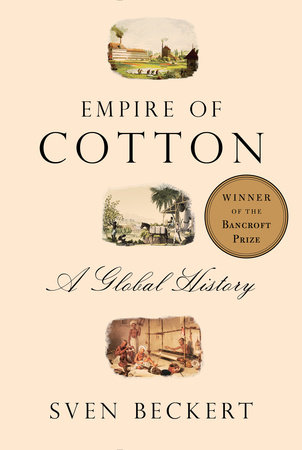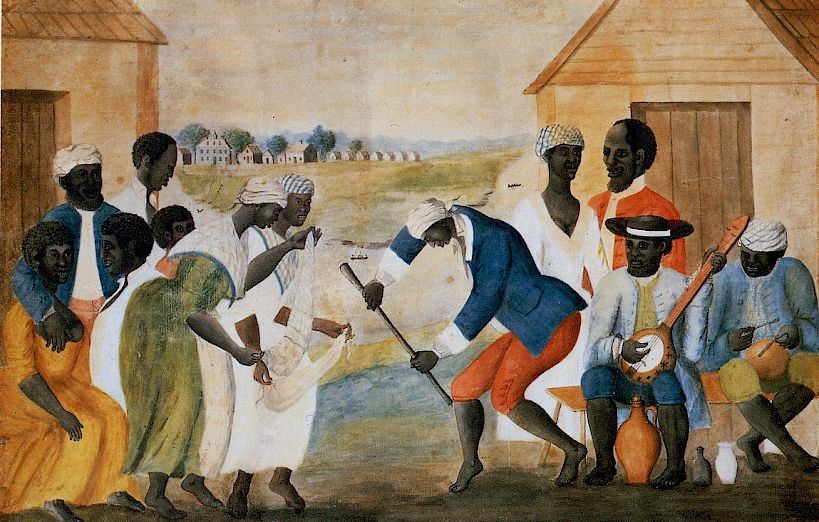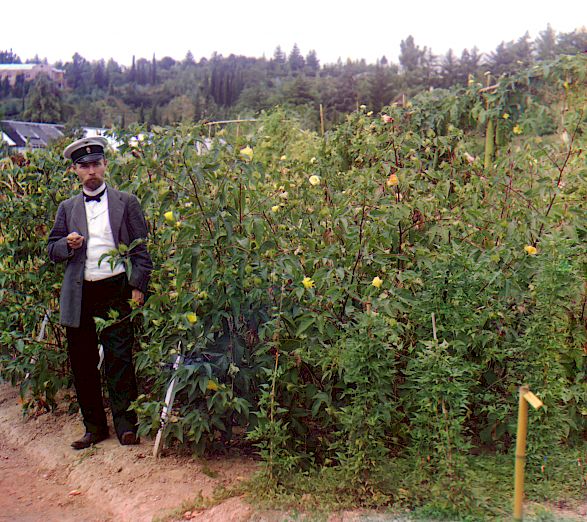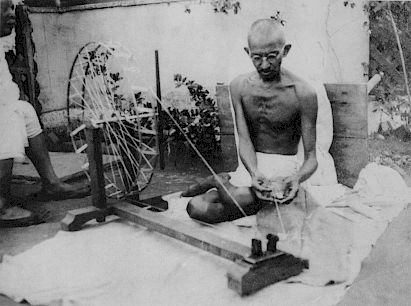Unweaving Sven Beckert's "Empire of Cotton: A Global History"
Pause for a moment while reading this review and check out the inside collar of your shirt or blouse. There's a good chance that the garment you're wearing is not only made out of cotton but was made in a country other than the one you're living in: Bangladesh, Cambodia, Vietnam, Guatemala, or somewhere else with appropriately low wages. Cotton, in short, is so much a part of our daily lives that its ubiquity as an industrial good and its central role in global trade are invisible. In an age of smart phones and Dreamliners, it's easy to forget how humble cotton remains one of the most valuable and widely traded goods on the planet.
It's easy, too, to forget that this plant has a history that is in large part the history of global capitalism–easy, that is, until the recent publication of Sven Beckert's Empire of Cotton, published in late 2014 by Random House. Beckert, originally from Germany and the co-director of Harvard University's Weatherhead Initiative on Global History, was already well-known to many American colleagues as a historian of capitalism. His 2001 The Monied Metropolis was a key early work in a generation of scholarship that has transformed a subfield formerly thought of as dusty, if not dead, into one of historical academe's growth areas. Indeed, Beckert was an early champion of the field at Harvard, founding a Program on the subject there, and has helped shaped many a dissertation project–Louis Hyman on debt in modern America, Vanessa Ogle on time synchronization, Ian Klaus on trust and capitalism–in a burgeoning literature. But with Empire of Cotton, Beckert takes an approach that is still often focused on Anglophone, if not just American capitalism, and seeks to apply it to one of the greatest global goods of all time.

A global history of cotton, Beckert explains in Empire of Cotton, is enlightening for several reasons. Firstly, its spatial organization shifted radically during the last three hundred years. Due to the difficulties of growing cotton in cold, damp Europe, Eurasia or North America, it should come as no surprise that most cotton cultivation–and, for ages–production was confined to local industries in places like China and, above all, India. But by the 18th and 19th century, a radical shift was underway, as the finished production of cotton goods shifted towards what we now identify as the industrial heartlands of the North Atlantic economy: the textile mills of northern England and a panoply of mill towns in Continental Europe and North America.
Today, however, the overwhelming majority of cotton production occurs back in the Global South, with China, India, Pakistan, Uzbekistan, and Turkmenistan among the top producers. Secondly, as a good that thrived both under conditions of slavery and under free labor, under colonialism as well as post-colonial conditions, cotton's evolving role promises to shed light on the role of the state, and empire, in the making of modern capitalism. Finally, because cotton was the true global good, with market developments in Georgia potentially upsetting producers or consumers from Liverpool to Bombay to Tokyo, it forms an ideal lens through which to examine the emergence of a "global condition"–a sense that developments in one part of the planet could not but be connected with those in its other corners.

Beckert's story kicks off with a brief and informative pre-history of cotton cultivation. Although unaware of one another, for thousands of years people living in the geographic band between 35 degrees south and 37 degrees north–cultivated cotton seed and used in garment production. (For comparison, Gibraltar sits at around 37 degrees north.) People in what is today Pakistan were probably the first to spin and weave the plant, leading to the establishment and, over hundreds of years, legendary quality, of the Indian textile industry. Travelers like Marco Polo marveled at Indian silks and muslins, and indeed not until after hundreds of years of copying and contact could Atlantic mills match top-flight Indian crafts. Spanish explorers in the New World were also impressed by Aztec textiles, too.
Still, although cotton garments made perfect sense as a good to be traded via Lisbon, Madrid, Istanbul and London to European markets, the idea that Europeans would direct the manufacture of the material seemed outlandish. Not only was it too cold in virtually all of the Continent to grow the plant. More than that, Europeans were, at best, only as productive as Indians, Chinese, or other producers at weaving the material, and the quality of their goods was much worse. Cotton seemed likely to remain a home-woven good, if also "the world's most important manufacturing industry." For that was just industry was then: not factories, but home production. Indian merchants cleaned up on markets around the Indian Ocean, Red Sea, and Persian Gulf, and one Ottoman official was not alone when he complained in 1647 that "So much cash treasury goes for Indian merchandise that the world's wealth accumulates in India."
It's worth noting that Europe's encounter with cotton didn't begin in the British Isles; rather, Ottoman merchants and Moorish conquerors brought āl-qutun to Iberia, and in the 1450s a cotton industry flourished in northern Italy, thanks to access to skilled workers and Mediterranean cotton sources. Increasingly, however, manufacturers in German-speaking Europe with access to cheaper spinners and wavers in the countryside challenged Milan for preeminence. Much of the Italian success owed to the lack of Ottoman power in the Eastern Mediterranean. By the 1580s, the Sultan granted select English merchants access to ports like Izmir, but few would have placed bets on the European cotton industry by that point: Europeans had not yet figured out how to subjugate the places that actually grew the crop, and it was still not clear whether a trading economy centered around the Atlantic could promise the crop.
Fortunately–for the Europeans if not for South Asians and Africans–this changed dramatically over the next two hundred years. Portuguese and, later, English penetrations into the Subcontinent brought trading fleets (not just isolated adventurers) in contact with fine Indian wares. Cotton cloths soon became the East India Company's most important export. English merchants succeeded in connecting Bengal not just with Britain, moreover, but also with purveyors of fine clothes in West Africa. All the same, the core of the business remained hand weavers tucked into the countryside, while a complex web of Ottoman, Persian, Arab, and South Asian traders competed with them to secure the cloth.
It was through a novel fusion of industrial capitalism (factories in the metropole) and war capitalism (violent, militaristic domination, typically in a colonial setting) that the British, above all, were able to transform the global context in which cotton moved. Following the "discovery" of West Indian islands that became test sites themselves for cotton growing, but above all for tobacco, the British and French began kidnapping and shipping West Africans to staff the plantations there. Slave bodies needed clothing. Soon, a virtuous–if that is the right word to describe a brutal system–circle emerged. Caribbean agricultural goods went to European consumers; Indian cloths were sold to West African traders, indeed slave traders, to finance the movement of black bodies across the Atlantic. Cotton had moved across oceans before, but never in such a global fashion. It was not the only time that cotton's history would be interwoven with that of slavery.

The trick of the system was that it didn't require on ingenuity per se – only, writes Beckert, "the capacity of rich and powerful Europeans to divide the world into an 'inside' and an 'outside.' The 'inside' encompassed the relative safety of the mother country, where state-enforced order ruled. The 'outside,' by contrast, was characterized by imperial domination, the expropriation of vast territories, decimation of indigenous people, theft of their resources, enslavement, and the domination of vast tracts of land by private capitalists with little effective oversight by distant European states."
But the Industrial Revolution in England changed that. That there would be a domestic textile industry, and in cotton at that, in cold, damp, muddy, rainy England, must have seemed implausible. Not only that, given the gigantic demand for slaves in the New World, there was more and more high-quality Indian fabric making its way to Africa and Europe. Concerned, manufacturing élites, fearful that the East India Company would put their nascent industry out of business, began lobbying for protectionist measures. Left out of bans, of course, were the Indian textiles that were destined for places like Guinea, for the slave system was the whole basis for the capital sloshing around the triangle in the first place. Manufacturers began closely copying Indian designs, and even where they failed to match Indian quality, the trade had so expanded the African market that even lower-quality French and English wares could find a market there. Once water-powered mills entered the picture in northern England, English manufacturers were able to "wrest the empire of cotton from the east within a vigorous generation of invention. Vastly improved productivity meant that the hitherto-unmentioned Indian advantage (lower labor costs) could be surmounted.
Soon, the British textile industry was so productive that the textile industry in Bengal was devastated. The tastes of British society had been transformed thanks to high-quality textiles, but it bears not forgetting that clothing also went to those parts of the world where consumers had no choice of what to wear–namely, slaves. But, it also bears recalling, these slaves were people producing sugar, tobacco, and rum, not cotton. As Beckert reminds the reader, while some of the cotton that entered Liverpool did so from slave colonies like Port-au-Prince and Port Royal, much, too, did from Izmir, Salonica, and Bombay–not slave colonies. Many of these sources struggled to keep up with British demand for raw cotton, though. Many, like Constantinople, lacked the features of the war capitalist state needed to mobilize bodies, and soon became marginal to overall British supply.
The Caribbean was more promising. There, islands like Barbados and St. Dominique became "commodity frontiers" for cotton. The crucial difference, argues Beckert, was not the climate or the financing involved, but rather "the recreation of the countryside through bodily coercion, something only possible under war capitalism." A so-called "second slavery" emerged around this time, as half of all slaves sent to the New World between 1492 and 1888 arrived after 1780. But what if the slaves revolted? Precisely this nightmare (from the point of view of cotton traders) happened in St. Dominique in 1791, when, in the largest slave revolt in history, rebels overthrow the French colonial regime and abolished slavery on the island. A quarter of British cotton imports were thus cut off, and at precisely the time when demand had never been higher.

America was the next stop. It was not an obvious choice. Americans owned slaves, of course, but they used them to grow indigo, tobacco, rice, and sugar, not cotton. Cotton was primarily associated with the Ottoman Empire, the West Indies, and Brazil, but not North America. But as British productivity drove up demand for raw materials and, especially after 1791, supply actually dropped, some Southern planters decided to test their luck. Planters in Sea Island, South Carolina, experimented with the crop, using roller gins adapted from Indian churkas to perform the onerous task of cotton picking. Thanks, however, to Eli Whitney's 1793 invention of the cotton gin, a bottleneck had been transformed, and planters could expand. While cotton wrecked the soil for 2-3 seasons after harvest, intermittent price booms in the early 19th century prompted planters to move further and further inland into the South. If in 1811, one sixteenth of all American cotton came from west of South Carolina and Georgia, then by 1860 that figure was three-fourths of all cotton.
Of course, there were people on the land before the cotton-growers. As Beckert stresses, war capitalism again came into play. Indeed, what made the United States a, if not unique, then special laboratory for the development of capitalism, was that it was one big continental laboratory where industrial capitalism and war capitalism could unfold simultaneously. One day, the federal government could force Indians off of black soil in the South and deport them to Oklahoma; the next day, planters could move into areas supremely suited for cotton cultivation and look forward to financing from Northern banks. By 1850, writes Beckert, "67 percent of U.S. cotton grew on land that had not been part of the United States a century earlier."
While placing due emphasis on the central role that the American South played in the global empire of cotton, Beckert is sensitive to show how interconnected this cotton workshop was with other parts of the world, financially and otherwise. Always a good investment, cotton required the financial intermediation of New York as not just Northerners but also an international investing audience sought to get in on the action provided by the exploitation of black bodies. Indeed, as not just Beckert's Harvard colleague Walter Johnson but also younger researchers like Christopher Mapes show in their work, the American slave-industrial complex was a project backed by European finance and with dreams of futures in extra-Southern contexts.
Given the global interconnections of the American cotton frontier, it is little wonder, then, that the Civil War dramatically reshaped the world's imperial cotton landscapes. Already by mid-century British buyers worried that the Empire had become too dependent on American cotton exports, and saw the writing on the wall if Democratic Southerners could not expand the slave-cultivated range of King Cotton and, with it, the slave interests' permanent control over American political institutions. Indeed, planters understood better than anyone the role of the state in the making of their own fortunes could not but imagine the expansion of slavery westwards. For they also knew that the foundations of the system–which demanded on violence across the Atlantic and the resale of slaves from dying tobacco farms–attracted moral outrage. Exploiting the three-fifths clause in the Constitution, slaveowners could in theory perpetuate the system forever so long as it kept on expanding and more black labor kept flooding into the Deep South–and maybe into Texas and beyond.
When war did erupt over precisely such disputes within America, Union blockades realized European importers' worst fears. "Exports to Europe," writes Beckert, " fell from 3.8 million bales in 1860 to virtually nothing in 1862." The "cotton famine" spurred a new wave of experiments in cotton plantation across what Beckert calls the "global countryside," in places like Ottoman Anatolia, Berar in the Subcontinent, Alexandria, and in the Romanov's Central Asian colonies. By the time American slaves succeeded in a growers' revolt enabled by sectional splits in the American élite, they along with the non-slave workers in the imperial cotton landscape faced new dilemmas. Could one have a cotton economy without indentured labor? There were many parts of the world where labor existed in huge gluts–Egypt, India, Turkestan–but how to subdue it in the absence of the overwhelming force of military capitalism that the U.S. South had embodied?

The answer to this question consumes much of the back half of Empire of Cotton. Focusing on areas like Berar, Beckert shows how, from the late nineteenth century onwards, hundreds of thousands of agents sought to penetrate the global countrysides not with bayonets and cudgels (although there were those, too) but with debt, cash crops, railroads, and telegraph lines (the better to communicate world market prices to far-flung markets). Such improvements in communications also meant a decrease in the power of middlemen and a centralization of power in a couple of global cotton exchanges.
The classic pattern of imperialist trade criticized by J.A. Hobson and others emerged: a few fledgling cotton mills in Berar and Bombay aside, most of what India produced was processed in northern English mills. Conversely, in 1900, some 78% of British finished cotton exports were re-exported to India. Around this time, European cotton mills had even managed to copy coveted Indian patterns and dyes, fueling a crushing trend of deindustrialization and agrarian proletarianization in one imperial frontier after another. As we know thanks to the work of Mike Davis, too, the more interdependent the village economy in places like the Raj became with global commodities prices, the more calamitous the effects of boom or bust markets could be on farmers. The wrong combination of weather patterns and prices in Liverpool or New York could leave subsistence farmers-turned-cash croppers starving.

But the story of the state's penetration of the global countryside is not exclusively a British one; by 1930, Imperial Japan had become the top producer of cotton in the world. From the 1860s to the 1930s, too, Brazil, Mexico, and Argentina followed similar strategies of state-led industrialization to insulate themselves from destruction by British, German, and American exports. Indeed, the days of a North Atlantic cotton economy dominating the world were numbered. Destructive as the mobilization of the global countryside was for farmers, the accumulation of capital by indigenous merchants in places like Ahmedabad turned colonies themselves into formidable producers of cotton. From 1860 to 1930, Britain went from hosting 61 percent of the world's spindles to 34 percent.
Arguably, many of the wounds were self-inflicted, as the advancement of suffrage in the United Kingdom (especially after World War I) gave spinners themselves a weightier voice in domestic labor debates. Ironically, just as European empires had created a class of native capitalists eager to encourage the state's role in cotton capitalism, workers in the Global North grew concerned with civilizing the dangerous, dirty, and cruel shop floor. This led to huge wage differentials of the kind that make it more profitable to produce t-shirts in Cambodia or Bangladesh than in Manchester or North Carolina. Governments in Europe and North America began imposing protectionist regimes while also exploiting an "imperial dividend" to hold onto market shares in South America, Central Asia, and the Indian Subcontinent. The United States, whose "colony" had been an internal part of the country itself, once again had an arguably unique path, as northern manufacturers in search of cheap labor merely shifted the spindles south of the Mason-Dixon line.
But the writing was on the wall. As the Epilogue to Empire shows, the combination of decolonization and revolution in the 20th century gave more and more nationalist states the context that Brazilians and Japanese had possessed decades earlier. "Budding Asian capitalists and state-building nationalist," Beckert writes, "studied Europeans' penetration of territory and mastery over labor and applied those techniques to their own postcolonial and, eventually, even postcapitalist hinterlands." Both China, India, and the Soviet Union, all taking advantage of a modernizing state apparatus and, later, the emergence of chemical fertilizers and insecticides, oversaw huge increases in cotton production. China went from being insignificant on global markets in 1952 to becoming the third largest manufacturer of the stuff five years later. By 1963, the Liverpool Exchange was shut down, no longer needed for its original function. By 1980, China was the world's foremost producer of the "white gold," followed by the Soviet Union. Startlingly, notes Beckert, in Soviet Central Asia (hub for the Soviet cotton industry) most of the production increases were realized between 1950 and 1967, thanks to chemical improvements.
Deep institutional patterns of state violence were established by these transformations: post-socialist Uzbekistan still employs techniques close to slave labor to secure its annual cotton harvest, much of Xinjiang's production (5% of global exports) is thanks to a curious semi-military institution, the Xinjiang Production and Construction Corps (XPCC). As if to demonstrate the degree to which these stories are not only intertwined but touch the present, XPCC was recently revealed to be the leaser of 5% of Ukraine's farmland. What has become of XPCC's planned investments in Crimea, since occupied and annexed by Russia, is not clear.
Happily for future generations of researchers, however, Beckert's Empire of Cotton leaves open several lines of inquiry. Agricultural life may be the true universal experience, as recent Global History Forum guest Adam Tooze reminds us in his ongoing work; but the way in which international and/or state capital penetrated local cash crop frontiers varied greatly from region to region. Pursuing more research in this direction–as a group of Harvard global historians mooted at an April 2013 conference–would not only help flesh out some of Beckert's arguments, but also provide more coherence to the all-too-often asked question of what makes global history "global." The invasion of Beckert's "global countryside" took place in a bewildering number of contexts, and by putting comparative studies of agrarian labor regimes in both the global South and Europe (where, as Tooze reminds us, most people were peasants until the mid 20th century) could help coax scholars outside of national fields and conduct comparative or team studies that promotes a global history sensitive to "national" fields. Such comparative work, too, would better delineate those cases where global factors, like international capital investment, did play a very significant role in the creation of debt and cash crop frontiers (Argentina or India, say), and those where state power took on a dominant role in the refashioning of the countryside–say, the Northern Caucasus or the Ferghana Valley, both in the Soviet Union.
Indeed, for this reader of Empire of Cotton–trained as a historian of Russia and the Soviet Union–one of the most startling research horizons the book opens is the study of what one might dub the global socialist countryside. For cotton as much as for other goods, both the Soviet Union and other single-party Marxist-Leninist dictatorships recognized the centrality of the agrarian question to their schemes. Not for nothing did Lenin call recognition of Russian peasants' seizure of the land a "peasant Brest-Litovsk," and as the American historian of Eastern Europe Timothy Snyder argues in his 2010 Bloodlands, much of the Eastern Front of the Second World War can be seen as a battle for a Ukrainian agro-colony. True, both of these wars over control of the Eurasian countryside revolved around grains, not cotton. But as historians like Alexander Morrison remind us for the nineteenth century, the story of cotton in much of the Tsarist Empire was much more a reaction to, rather than an impulse for, Petersburg's conquest of Central Asian Khanates and Emirates. As for the Soviet period, Sergeĭ Abashin's recent Soviet Kishlak: Between Colonialism and Modernization follows the history of Oshoba (population: 15,000), in northern Tajikistan during the entire late colonial and Soviet period, showing how one locality was transformed by crash programs to remake the agricultural landscape of the cotton-producing (but not only) Ferghana Valley.
It is far from clear whether the story for other regions of the Soviet Union, or indeed for other goods across the collectivized global socialist countryside, is at all the same. One hopes that the next generation of global history will see scholars ready to write for Cuban history what Sidney Mintz's Sweetness and Power was for a previous generation; or of the history of coffee in, say, Nicaragua or Ethiopia. Ditto for much of the agricultural economy in Cambodia under the Khmer Rouge, then, later, as a Vietnamese protectorate. In short, many of the questions that the reception of Empire of Cotton associates with the "history of capitalism" might just as productively be posed of the history of socialist state economies. Raising those questions, too, would also help break down area studies-inflected boundaries between, for example, scholars of Central America, Siberia, East Germany, and Southeast Asia–all countries touched by a traveling "socialist cloud" of agricultural information and expertise, even if not all of the countries that touched the Soviet empire went after full-blown collectivization. The history of agrarian regimes is a topic that promises to reward not just scholars of American capitalism, in short.
Of course, these remarks should be taken less as criticisms of holes in Empire of Cotton than examples of the research agenda that the book sets up. More than anything, however, Beckert's achievement in tackling such a large topic in global history–and pulling it off–is to demonstrate once more that a global approach means more than idle speculation about the history of the world, or about how everything is connected to everything. Rather, as Empire of Cotton shows, there are themes where a global perspective, beyond just an imperial point of view, is necessary to comprehend the full picture. Adopting such an approach doesn't mean writing individuals out of the narrative, nor does it mean lower methodological standards (Empire of Cotton draws on archives from every continent). Global history is real as a discipline, and promises to become only more richly institutionalized as a generation of scholars from a variety of ostensibly national fields realize that theirs is, in fact, a global conversation. Here's to a work, then, that forces us to reconsider not just the history behind the shirts on our backs, but how we write that very history itself.